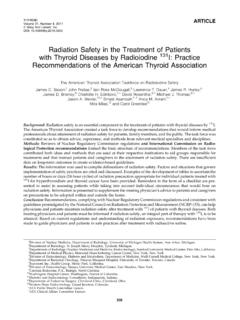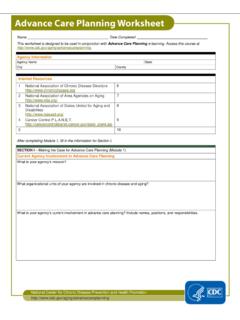Transcription of Recruitment & Retention Cover - AHVRP
1 Recruitment & Retention Guide for Volunteers American Hospital Association Committee on Volunteers (COV). Best Practices and Recruiting and Retention Resource Guide for Healthcare Volunteers Recruitment and Retention are vitally important to healthcare volunteerism. These interrelated issues directly affect the success of volunteer organizations. This Resource Guide was developed to assist volunteer leaders in recruiting and retaining volunteers for their organizations. To successfully recruit volunteers for your organization, you must be able to explain in an enthusiastic, informative, and convincing manner what your organization is about, and why someone would want to be a part of it. Equally important is placing the new members in positions that are compatible, satisfying, and challenging.
2 This Resource Guide provides the tools for the successful recruiting and Retention of Volunteers. Thanks to the 2003 Volunteer Summit Team for their expertise and many hours of dedication to this project. Thanks also to all contributors of this Resource Guide. Wilma Boldt, Chair AHA Committee on Volunteers American Hospital Association One North Franklin Chicago, Illinois 60606. (312) 422-3100. TABLE OF CONTENTS. WHY PEOPLE VOLUNTEER ..3. Recruitment Set The Stage For Effective Recruitment By ..4. WHAT BENEFITS CAN YOU OFFER POTENTIAL VOLUNTEERS ..4. Where Are Potential Volunteers Hiding ..5. How Do You Create Visibility For Your Volunteer Organization ..6. TRAINING Retention STRATEGIES ..8. RECOGNITION SUMMARY CHECKLIST FOR RECRUITING & RETAINING ..11. Recruitment & Retention BEST PRACTICES.
3 13. Alabama, California, Napa/Solano Area ..16. California, Redding ..17. California, Walnut Creek ..19. Florida, Jacksonville ..22. Georgia, Augusta ..24. Iowa, Council Bluffs ..25. Kentucky, Danville ..26. Massachusetts, Maryland, Michigan, Lansing ..29. Minnesota, Missouri, Kansas City ..31. New Jersey, New Mexico, Las New York, Albany ..38. New York, Kingston ..39. North Carolina, North Carolina, Kinston ..41. Oklahoma, Oklahoma 101 WAYS TO GIVE RECOGNITION TO RESOURCES ..45. VOLUNTEER WEBSITES ..47. ACKNOWLEDGEMENTS ..49. 1. PREFACE. In 1998, reports from state auxiliary leaders and professionals in the field of healthcare volunteerism confirmed a critical decline in the number and diversity of healthcare volunteers. Author, lecturer and consultant Steve McCurley warned State Auxiliary Leaders: In the absence of a concerted effort to reverse trends, hospital volunteering will become irrelevant in the next 15 years.
4 The reality that our hospitals and the volunteers serving them were faced with a serious threat was the catalyst to motivate these volunteer leaders to launch the idea for Volunteer Summits designed to enhance the image of our special brand of volunteerism. A collaborative alliance made up of members of AHA, the AHA Committee on Volunteers, the American Society of Directors of Volunteer Services, Veteran's Association Voluntary Chiefs, State Auxiliary Leaders, and auxilians and volunteers across the nation put together plans to advance the cause of volunteerism and volunteer leadership. Collaborative teams (Vision & Values, Research & Reporting, Funding Communications, Resource/Events, and Publicity) planned three Summits in conjunction with the ASDVS/Auxiliary/Volunteer Annual National Conferences.
5 The goal of this initiative is to recognize the reality and promote the potential of healthcare volunteerism and thus draw positive attention to healthcare volunteerism and encourage a younger and more diverse group to join us as we serve our institutions and communities. This Recruitment & Retention Guide has been assembled through the efforts of AHA, the AHA Committee on Volunteers, the Summit Resource/Events and Communication Teams and is the culmination of the Summit campaign. It addresses the subject that has been at the heart of the four-year initiative. We thank all who submitted their outstanding programs, which will be valuable resources for those striving to revitalize their volunteer programs by improving the image of who we are and what we do for our hospitals and communities.
6 It is a positive step toward making healthcare volunteerism the Number One choice of everyone interested in donating his or her time and talents in a volunteer role. Rosemary Fox, Coordinator Volunteer Summit Team 2. RECRUITING AND RETAINING VOLUNTEERS. INTRODUCTION. Volunteers are the lifeblood of every hospital in our country. Year after year, they contribute time and energy to assist their hospital by: Responding to the needs of patients, patients' families, hospital staff, and visitors. Promoting the hospital and auxiliary as a caring organization. Enhancing community understanding of health care through educational programs and outreach activities. Maintaining ongoing sources of revenue to meet present and future requirements. (In some hospitals.). WHY PEOPLE VOLUNTEER.
7 People volunteer for many different reasons, such as: Helping others. Making new friends. Building self-confidence. Having a sense of well-being and connectedness to others. Gaining personal growth. Fighting boredom. Establishing a new direction in life. Giving something back to the community and/or institution (hospital). Sharing talents, abilities, and experiences. Learning new skills. Gaining training. 3. Feeling needed, useful, and appreciated. Gaining membership benefits. Having fun and enjoying themselves. Recruitment STRATEGIES. Set The Stage For Effective Recruitment By: Assessing the needs of your hospital and your community. Creating a mission and vision statement that clearly ties into the mission of the hospital. Collaborating with hospital staff for needs in their departments.
8 Designing diverse opportunities for volunteers. Developing creative, comprehensive, value-added assignments, , volunteers training other volunteers, position sharing, cross training, etc. Considering the diversity of individuals who volunteer. Being aware of community demographics and volunteer trends. What Benefits Can You Offer Potential Volunteers? Your hospital volunteer organization is just one of many organizations competing for volunteers. What makes your group a special or attractive organization for the volunteer? Market the positive aspects that your organization offers to volunteers: Establish friendships. Develop skills. Rewards of involvement. Education opportunities. Training opportunities and personal development and growth. 4. Social interaction. Feeling of self worth.
9 Where Are Potential Volunteers Hiding? They are all around you. They are: Members of your family. Social and spiritual friends. Active adult communities. Students in school, college, and vocational centers. Pre or post retirement individuals. Hospital patients. Former volunteers. Local volunteer centers. Members of service organizations, , Kiwanis, Rotary, AAUW, etc. Members of other organizations, , AARP, Senior Citizens, singles groups, retired teachers, etc. People in support groups, , heart, cancer, prostate cancer, etc. Health clubs and those assisting with golf or tennis tournaments. Corporations and businesses. Law enforcement agencies. Work force (volunteer hours required by employers). Unemployed or prospective employees. Shut-ins for work at home, crocheting, knitting, etc.
10 5. How Do You Create Visibility For Your Volunteer Organization? Making volunteering appealing: put some sizzle into Recruitment ads, etc. Promoting National HealthCare Volunteer Day. Preparing volunteer position descriptions to include short term/episodic, virtual and other options. Making clearly defined volunteer information readily available. Making certain that the volunteer center, Internet volunteer website, local library, Chamber of Commerce, newcomers group, convention/visitors bureau have up-to-date information about volunteering in your organization. Identifying target groups and how to market them. Creating a speaker's bureau by training volunteers to give presentations. Holding Recruitment meetings, similar to Tupperware parties, in volunteer's homes.







